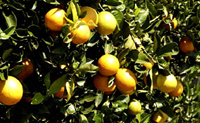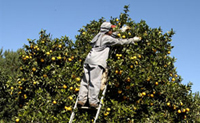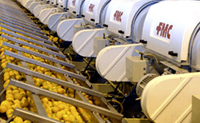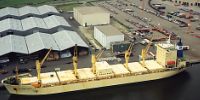Commercial production of fruit Juice is much more than just squeezing the Juice out of a fruit. In order to illustrate this let’s use the Orange as an example. We will follow the fruits journey from the nursery to the Orange Juice on your table.
Plant an Orange s eed and you have to wait at least 15 years until you can pick your first Orange – and there is no guarantee that it will be enjoyable!
eed and you have to wait at least 15 years until you can pick your first Orange – and there is no guarantee that it will be enjoyable!
In the commercial world the Orange growers are buying young trees from a nursery where they have planted seeds to get a good and strong rootstock. On this tree they have grafted a bud from the variety of Oranges they want to grow. Now it will take 3 years until your first small crop of Oranges. Gradually the size of the crop will increase during the next 15 years and then stay rather stable for the next 10 years. After that it is generally time to replace the tree with a new one. Depending on where in the world the tree is growing it can actually become as old as 100 years, but from a commercial point of view the life cycle is more like 25 – 30 years.
 Oranges growing on the same tree do not ripen at the same time. It is therefore important that the fruits are carefully selected before being picked, which means that picking has to be made by hand. Many attempts have been made over the years to develop mechanical harvesters but so far the results are not good enough. A fully grown Orange tree can hold as many as 2.000 pieces of fruit, which translates to about 200 liters of Juice. An experienced picker may pick as much as 3.000 kgs during a day.
Oranges growing on the same tree do not ripen at the same time. It is therefore important that the fruits are carefully selected before being picked, which means that picking has to be made by hand. Many attempts have been made over the years to develop mechanical harvesters but so far the results are not good enough. A fully grown Orange tree can hold as many as 2.000 pieces of fruit, which translates to about 200 liters of Juice. An experienced picker may pick as much as 3.000 kgs during a day.
From the plantation the Oranges are transported to the processing facility. It is important to take care of the fruit as quickly as possible and as a rule no fruit is being stored more than 24 hours before further processing. First the fruits are washed, often with water obtained during the concentration of the Juice. Then they are inspected and sized before going into the extractors where the Juice is squeezed out of the Oranges at very high speed.
 The next step is the finishing of the Juice, i.e. taking away seeds, fruit pulp, etc., and then the Juice is going into a blending tank. From here it can be pasteurized, stored as single strength Juice and marketed as “Freshly squeezed Orange Juice” or it can be concentrated. The main reason for the concentration is to reduce the quantities going to storage and transport. Through a process of heating the Juice under vacuum water is evaporating and you are left with a concentrate. Roughly 80% of the original volume is evaporating and the remaining 20%, i.e. the concentrate, is stored at between minus 8 and minus 18ºC. Some aromatic substances in the Juice are lost during the evaporation process but can be captured and returned to the concentrate or to the reconstituted Juice before being filled into retail packages.
The next step is the finishing of the Juice, i.e. taking away seeds, fruit pulp, etc., and then the Juice is going into a blending tank. From here it can be pasteurized, stored as single strength Juice and marketed as “Freshly squeezed Orange Juice” or it can be concentrated. The main reason for the concentration is to reduce the quantities going to storage and transport. Through a process of heating the Juice under vacuum water is evaporating and you are left with a concentrate. Roughly 80% of the original volume is evaporating and the remaining 20%, i.e. the concentrate, is stored at between minus 8 and minus 18ºC. Some aromatic substances in the Juice are lost during the evaporation process but can be captured and returned to the concentrate or to the reconstituted Juice before being filled into retail packages.
 The Juice concentrate can be stored for a long time without loosing quality. From the main production areas in the world, i.e. Brazil and Florida, the concentrate is transported in either bulk vessels or in steel drums with double plastic liners. The bulk concentrate is kept at minus 8 – 10ºC, a temperature at which the concentrate can still be pumped and kept for long time storage without any quality deterioration. The reason why the concentrate is not frozen solid is because of the high natural fruit sugar content. From the vessel the concentrate is pumped into big tanks at designated Orange Juice terminals, which can be found in Belgum, The Netherlands, USA, Australia and Japan. From the terminal the concentrate is going in road tankers or tank containers to the final destination.
The Juice concentrate can be stored for a long time without loosing quality. From the main production areas in the world, i.e. Brazil and Florida, the concentrate is transported in either bulk vessels or in steel drums with double plastic liners. The bulk concentrate is kept at minus 8 – 10ºC, a temperature at which the concentrate can still be pumped and kept for long time storage without any quality deterioration. The reason why the concentrate is not frozen solid is because of the high natural fruit sugar content. From the vessel the concentrate is pumped into big tanks at designated Orange Juice terminals, which can be found in Belgum, The Netherlands, USA, Australia and Japan. From the terminal the concentrate is going in road tankers or tank containers to the final destination.
 Single strength Juice (NFC Juice), can be stored for a long time in frozen condition in drums or it can be stored and transported chilled in aseptic tanks. Designated bulk vessels are carrying huge amounts of NFC Orange Juice from Brazil to the terminals mentioned above. The transport from the terminals to the final Juice bottler is a very critical phase of the distribution chain. The temperature must be monitored closely and the Juice has to go directly into production once it reaches the final destination.
Single strength Juice (NFC Juice), can be stored for a long time in frozen condition in drums or it can be stored and transported chilled in aseptic tanks. Designated bulk vessels are carrying huge amounts of NFC Orange Juice from Brazil to the terminals mentioned above. The transport from the terminals to the final Juice bottler is a very critical phase of the distribution chain. The temperature must be monitored closely and the Juice has to go directly into production once it reaches the final destination.
During the concentration process water was taken away from the Juice. The very same amount of water is added back to the concentrate before it can be filled into the final consumer package. To keep the natural good Orange Juice taste it is important to use high quality pure water in the reconstitution process and it is equally important to give the Juice a mild pasteurization prior to the filling.
The NFC Juice is just given the mild pasteurization and maybe an addition of Orange Pulp Cells before it goes into the retail package.
Now, finally, the consumer can enjoy the delicious Orange Juice, without really bothering about all the stages it has gone through from the plantation on the other side of the globe to the breakfast table!